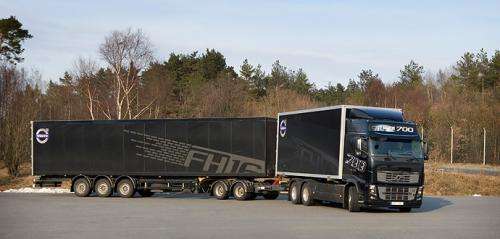Trucks that are between 18.76 and 25.25 metres long are more eco-friendly than the shorter "European" trucks. Research at Chalmers University of Technology now also shows that these vehicles are at least as safe as shorter trucks in traffic. Testing with even longer trucks is currently ongoing in Sweden.
The maximum allowed truck length in most of Europe is 18.75 metres, but there are a few exceptions, primarily in Scandinavia. The maximum allowed length in Sweden today is 25.25 metres, such as the truck in the image above.
A comparative statistical study was performed by researchers at the Safer Vehicle and Traffic Safety Centre at Chalmers in order to gauge the effect of the difference on traffic safety. They compared how often heavy trucks of different lengths were involved in severe crashes or fatal crashes, by vehicle kilometres travelled, in Sweden over a ten-year period between 2003 and 2012.
The trucks in the study were assigned to one of three length groups:
- long truck combinations of 18.76-25.25 metres
- medium combinations of 12.01-18.75 metres
- short combinations under 12 metres
Results show that long trucks were involved in slightly fewer severe crashes or fatal crashes per billion vehicle kilometres travelled than were medium trucks. Short trucks were involved in approximately three times as many severe crashes or fatal crashes per billion vehicle kilometres travelled than were long trucks.
"We have thus not found any signs that long trucks are less safe than regular European trucks," says András Bálint, who is a traffic safety analyst at Safer. "However, it should be noted that the exposure data was not classified by road type or type of area. Thus, it is possible that long truck combinations demonstrated better performance than the other combinations because they operate in a safer road environment. Another possible reason for the difference might be that the most experienced drivers usually drive the longest trucks."
"The results show, however, that with current traffic habits such as road and driver selection, the longer Swedish trucks are involved in fewer severe crashes or fatal crashes per billion vehicle kilometres travelled in Sweden than are European truck combinations."
The study is a project within the HCT programme being conducted at Safer, and it is funded by the Swedish Transport Administration. High capacity transport (HCT) refers to trucks that are longer and heavier than what is currently allowed in Sweden. HCT trucks are allowed in Canada, the U.S., Australia and Brazil, for example. HCT vehicles provide lower costs, energy consumption and emissions of greenhouse gases in terms of transported volume of goods than do regular trucks.
The HCT programme is examining what the effect on traffic safety would be if high capacity transports were allowed. Testing is already ongoing in Sweden with more than ten trucks that are over 30 metres long and that weigh up to 90 tonnes.
"The results of Safer's study on trucks do not address what the frequency of crashes would be with high-capacity vehicles," says András Bálint. "However, it is important to know that the longest allowed truck combinations already in use have not performed worse than the other length groups."
More information: Crash data for the 10-year period between 2003 and 2012 was obtained from Strada, the Swedish national crash database, while the exposure data was obtained from statistics provided by Transport Analysis, a Swedish government agency. Read the study: acrs.org.au/wp-content/uploads/66_Balint_NPR.pdf
Provided by Chalmers University of Technology





















